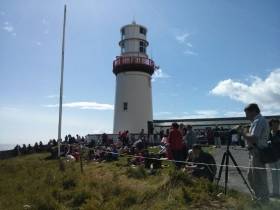Displaying items by tag: AllIreland Whale Watch Day
Look To The Sea On All-Ireland Whale Watch Day Later This Month
#MarineWildlife - 2017’s All–Ireland Whale Watch Day is scheduled for Saturday 26 August between 2pm and 5pm as part of Heritage Week.
Join the Irish Whale and Dolphin Group (IWDG) at any of 20 land-based whale watches across Ireland to celebrate the 26th Anniversary of Irish waters being declared a sanctuary for whales and dolphins and find out about the 25 species of cetaceans – porpoises, dolphins and whales – recorded to date around the coast.
All watches are land-based and will be led by experienced IWDG researchers, enthusiasts and whale watchers who will show you how to observe and identify some of the more commonly-recorded cetacean species seen in Irish waters.
The event also provides IWDG researchers with a unique snapshot of whale and dolphin activity around the Irish coast on the same day.
Please bring binoculars or a spotting scope if you have them and dress appropriately for outdoor conditions. There are no boat trips involved and there is, of course, no guarantee that you will see whales or dolphins at your chosen site – but at last year’s event, whales or dolphins were recorded at 15 of 20 sites.
So if the weather is suitable on the day, you’ve quite a good chance of seeing some really interesting marine wildlife. And in the process, you’ll be supporting whale and dolphin conservation in Ireland.
The full list of watching locations, with watch leader contacts, is as follows:
- Clogherhead, Co Louth - Port Oriel Upper Car Park - Breffni Martin 087 9145363
- Howth Head, North Dublin - Balscadden Car Park - Conal O’Flanagan 086 3537900
- Killiney Bay, South Dublin - Vico Road - Isabel Baker 086 4057633
- Bray Head, Co Wicklow - Pitch & Putt Car Park - Justin Ivory 087 6833898
- Wicklow Town - Black Castle Car Park - Brian Glanville 087 1390665
- Hook Head, Co Wexford - Hook Head Lighthouse - Harm Deenen 086 3485013
- Ardmore Head, Co Waterford - Ram Head Signal Tower - Andrew Malcolm 087 7952061
- Galley Head, Co Cork - Lighthouse - Pádraig Whooley 086 3850568
- Lehanemore, Beara, Co Cork - Lehanemore Community Centre - Patrick Lyne 027 71930
- Valentia Island, Co Kerry - Bray Head Signal Tower - Sean O’Callaghan 085 7764918
- Clogher Head, Co Kerry - Layby - Nick Massett 087 6736341
- Loop Head, Co Clare - Loop Head Lighthouse - Simon Berrow 086 8545450
- Black Head, Co Clare - Black Head Lighthouse - Sandra O’Donovan 086 6061869
- Downpatrick Head, Co Mayo - Car Park - Aoife Foley 085 8276984
- Mullaghmore Head, Co Sligo - Mullaghmore Layby - Miriam Crowley 087 6171377
- Bloody Foreland, Co Donegal - Foreland Heights Car Park - Gareth Doherty 086 2223328
- Inishowen Head, Co Donegal - Tower - Trish Murphy 087 6748183)
- Portstewart Head, Co Derry - Car Park - Jim Allen 078 76516032
- Portmuck, Co Antrim - Car Park - Ian Enlander 028 93372724
- Bloody Bridge, Co Down - Car Park - Dave Wall 077 71762355
























































